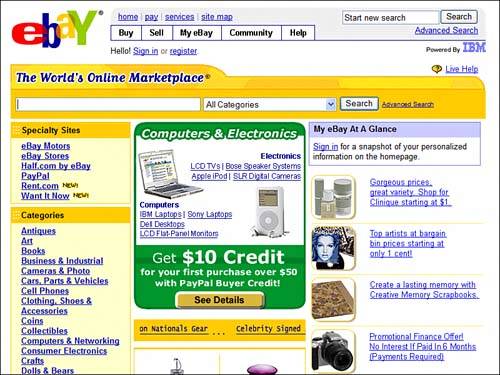| If you've never used eBay before, you might be a little anxious about what might be involved. Never fear; participating in an online auction is a piece of cake, something tens of millions of other users have done before you. That means you don't have to reinvent any wheels; the procedures you have to follow are well-established and well-documented. note  | There is no cost to register with eBay, although if you want to sell items, you'll have to provide your credit card and checking account numbers. (eBay uses this information to help weed out potential scammers, and to provide a billing option for the seller's eBay fees.) |
An eBay auction is an Internet-based version of a traditional auctionyou know, the type where a fast-talking auctioneer stands in the front of the room, trying to coax potential buyers into bidding just a little bit more for the piece of merchandise up for bid. The only difference is that there's no fast-talking auctioneer online (the bidding process is executed by special auction software on the auction site), and your fellow bidders aren't in the same room with youin fact, they might be located anywhere in the world. Anyone can be a bidder, as long as he or she has Internet access. Here's how the auction process works, in general terms: 1. | You begin (as either a buyer or a seller) by registering with eBay. You can do this by clicking the Register link on eBay's home page, shown in Figure 23.1.
Figure 23.1. Where all the auction action startseBay's home page. 
| 2. | The seller creates an ad for an item and lists the item on the auction site. (eBay charges anywhere from $0.25 to $4.80 to list an item.) In the item listing, the seller specifies the length of the auction (1, 3, 5, 7, or 10 days) and the minimum bid he or she will accept for that item.
| 3. | A potential buyer searching for a particular type of item (or just browsing through all the merchandise listed in a specific category) reads the item listing and decides to make a bid. The bidder specifies the maximum amount he or she will pay; this amount has to be equal to or greater than the seller's minimum bid, or higher than any other existing bids.
| 4. | eBay's built-in bidding software automatically places a bid for the bidder that bests the current bid by a specified amountbut doesn't reveal the bidder's maximum bid. For example, the current bid on an item might be $25. A bidder is willing to pay up to $40 for the item, and enters a maximum bid of $40. eBay's "proxy" software places a bid for the new bidder in the amount of $26higher than the current bid, but less than the specified maximum bid. If there are no other bids, this bidder will win the auction with a $26 bid. Other potential buyers, however, can place additional bids; unless their maximum bids are more than the current bidder's $40 maximum, they are informed (by email) that they have been outbidand the first bidder's current bid is automatically raised to match the new bids (up to the specified maximum bid price).
| 5. | At the conclusion of an auction, eBay informs the high bidder of his or her winning bid. The seller is responsible for contacting the high bidder and arranging payment. When the seller receives the buyer's payment (by check, money order, or credit card), the seller then ships the merchandise directly to the buyer.
note  | Learn even more about eBay auctions in my companion book, Absolute Beginner's Guide to eBay, 3rd Edition (Que, 2005), available where you purchased this title. |
| 6. | Concurrent with the close of the auction, eBay bills the seller for a small percentage (starting at 5.25%) of the final bid price. This selling fee is directly billed to the seller's credit card.
|
|
